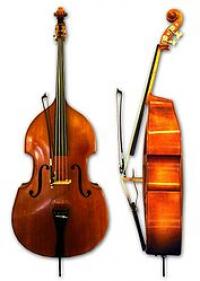Home | instrument | Double bass
|
|
|
The double bass stands around 180 cm (six feet) from scroll to endpin, and is typically constructed from several types of wood, including maple for the back, spruce for the top, and ebony for the fingerboard. It is uncertain whether the instrument is a descendant of the viola da gamba or of the violin, but it is traditionally aligned with the violin family. While the double bass is nearly identical in construction to other violin family instruments, it also embodies features found in the older viol family. Like many other string instruments, the double bass is played either with a bow (arco) or by plucking the strings (pizzicato). In orchestral repertoire and tango music, both arco and pizzicato are employed. In jazz, pizzicato is the norm, except for some solos and also occasional written parts in modern jazz that call for bowing. In most other genres, such as blues and rockabilly, the bass is plucked. When playing the double bass, the bassist either stands or sits on a high stool and leans the instrument against the bassist's body with the bass turned slightly inwards in order to reach the strings more easily. This stance is also a key reason for the bass' sloped shoulders, which mark it apart from the other members of the violin family, as the narrower shoulders facilitate playing of the strings in their higher registers. The double bass is a transposing instrument and sounds one octave lower than notated. |




 RSS
RSS